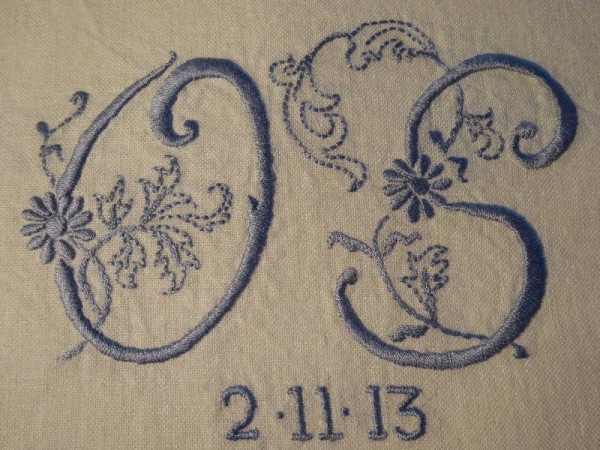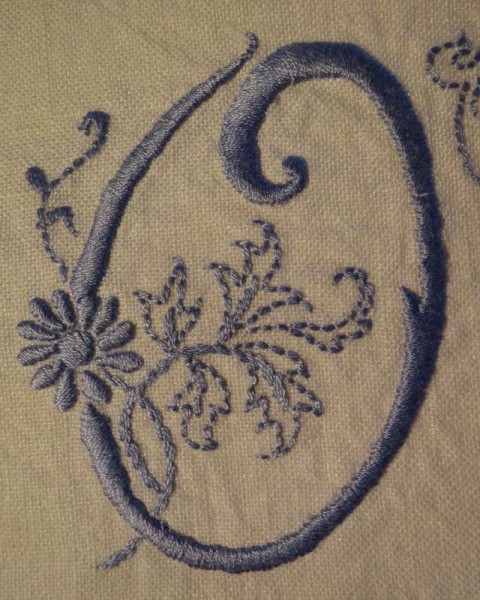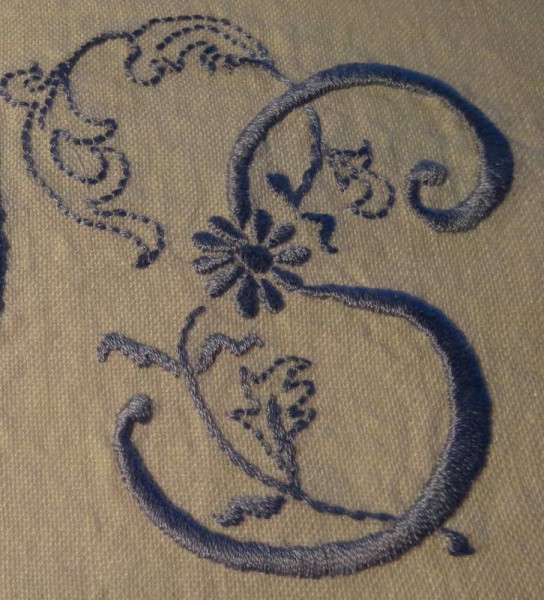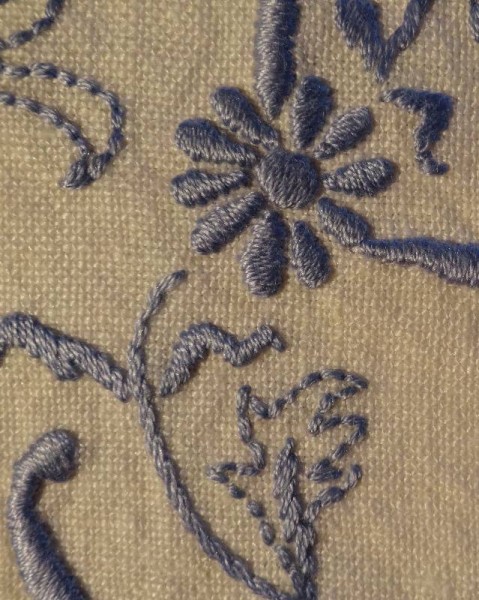Here is another break away from white-on-white embroidery, but this time I’ve chosen a light cornflower blue (DMC 341) which I often use as it is bright but with real depth of colour. The wedding is tomorrow and I’m quite overwhelmed by actually completing the present before going to the wedding. This is now the second time in a few months that I’ve done this, so perhaps I’m getting better at judging such things. I do hope so. (The proof of the pudding will be a bigger commission I have for the end of November – this November – for which the design is done but the needle has yet to breech the virgin fabric. Umm, let’s not think about it, as I shall be away for the weekend.) It is a miserable wet Friday and the light is not very good. A little flock of partridges have just wiffled down the field in gleaning mode and that has raised the spirits and distracted my mind away from having taken inadequate photographs in which the same white linen as here now looks yellow.
A needle loaded with this beautiful blue ploughing through its linen furrow has made thoughts of ‘the blue flower’ twirl round in my head like a song’s lyric you just can’t shake off and with it has come a memory of the book of the same name which similarly, once read, you can’t shake off. Penelope Fitzgerald’s book, The Blue Flower, was the last thing she wrote and is the purest example of ‘show, don’t tell’. A book of genius, it casts rents of light and little puffs of illumination on the short life of another genius (Novalis, German poet/philosopher, pseudonym of Georg Philipp Friedrich “Fritz” Freiherr von Hardenberg who is almost forgotten about today). A gifted boy’s love for an inconsequential 12 year-old (Sophie’s brain is “as empty as a new jug”) fuels a unique romantic, philosophical and scientific vision. Fitzgerald makes us feel this is possible and credible and that in just the tiniest pin pricks of similarity the ineffable in our lives is like this.
The blue flower, appearing first in one of Novalis’s novels (unfinished) as a source of inspiration, a conduit between human nature and the world beyond of the spirit, touched the zeitgeist and became the symbol of the wider German Romantic movement. For the Romantics life and death became intertwined concepts which, taken to their ultimate expression meant that death was a romantic principle of life. Sophie is the blue flower – an unquestionable obsession and guiding spirit. As with Dante and Beatrice, Sophie’s fading health and death is no final barrier to growth and enlightenment (I think).
Novalis’s philosophy in which the mind has full responsibility for creating and moulding the world it lives in stands as a contrast to the theme of Goethe’s “The Sorrows of the Young Werther” (1775, published 3 years before Novalis’s birth) where unrequited love, helpless, descends to a final and suicidal embrace with death. This was Goethe’s most popular and most influential novel (Napolean adored it and was said to have had it with him during his Eqyptian campaign. Extraordinary!) It is to Goethe’s eternal merit that he spent the rest of his life distancing himself from the novella. (Significantly, Werther obsesses over the blue coat he’d worn when he fell in love. Blue coats then became incredibly fashionable, to the point where even characters in near contemporary novels had to have such coats.)
For Philip Hensher, Fitzgerald’s narratives are “patterned rather than plotted, with scenes unfolding tangentially, like harmonies and counter harmonies in a piece of music” and “Just like Breughel does in ‘The fall of Icarus’, Fitzgerald enjoys letting her focus drift out across the surrounding vista.” So true is this that before re-reading all I could remember of the book apart from the oddly matched love story was the opening scene where drifts of soiled linen are being thrown from upper windows as the family house became turned inside out for the yearly wash day. Older and wiser, my return to the book has found further rewards.
The Great Tapestry of Scotland
Coincidentally, I have been following progress of this most wonderful work in the blog Cornflower. It can now be seen in its full finished glory here, so do look because the design, colour and workmanship are wonderful. I should love to see it close to but failing that I am grateful to Cornflower for making it available online.





4 Comments
Another beautiful piece of embroidery. And a new addition to my book list – thank you for such an interesting post.
By the way, I’ve been meaning to say, your husband baptised my younger son back in 1980. What was that I said about a small world?!
Well, thank you once again Harriet for leaving a kind comment.
I have trawled through your blog to find clues to jog my husband’s memory and your elder/eldest son’s birth tag has provided some information that’s started bells ringing – but he hasn’t got there …yet. This was presumably Bisley?
Mary
I like your use of wiffle in reference to the partridges. I love the cornflower blue too. Bx
Thank you, Becky
2 Trackbacks
[…] but daughter No 1 kept suggesting coloured initials – at first blue was the ideal colour but then again perhaps red would be rather wonderful. By the time I came to […]
[…] I enjoyed working with this lovely pale blue and it made me remember the last blue wedding initials I did almost a year ago and the post I wrote on Penelope Fitzgerald̵… […]